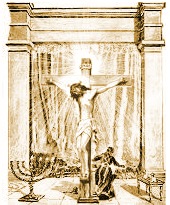|
|
|||||||||||||||||||||
 |
|||||||||||||||||||||
|
Learn Hebrew |
|||||||||||||||||||||
|
The Veil Torn in Two |
|||||||
|
The Significance of the Rent Parochet... |
|||||||
|
And Yeshua cried out again with a loud voice and yielded up his spirit. |
|||||||
|
"Forty years before the Temple was destroyed [i.e., 40 years before 70 A.D., or in 30 A.D.] . . .the gates of the Hekel [Temple] opened by themselves, until Rabbi Yohanan B. Zakkai rebuked them [the gates] saying, Hekel, Hekel, why alarmist thou us? We know that thou art destined to be destroyed..." |
|
|
|
Solomon's Temple was 30 cubits high (1 Kings 6:2) but according to Flavius Josephus, king Herod "the great" had increased the height to 40 cubits, that is, somewhere near 60 feet high (War of the Jews, Book V, Chapter 1, paragraph 5). The tearing of the parochet at the moment of Yeshua's death therefore dramatically symbolized that by His blood sacrifice as our Kohen Gadol after the order of Malki-Tzedek, the King of Righteousness (Hebrews 6-7), the way into the Kodesh Hakodeshim (Holy of Holies) was opened to those who come to God through faith in Yeshua as their Mediator.
Since then we have a great high priest who has passed through the heavens, Yeshua, the Son of God, let us hold fast our confession. For we do not have a high priest who is unable to sympathize with our weaknesses, but one who in every respect has been tempted as we are, yet without sin. Let us then with confidence draw near to the throne of grace, that we may receive mercy and find grace to help in time of need. (Hebrews 4:14-16) The rending of the veil represents, then, two major things. First, it means that the way of access to the LORD God of Israel has been opened up by means of the all-sufficient sacrifice of Yeshua for our sins (Romans 6:10). We no longer go through the "offices of Levi" (i.e., Judaism and its rituals) to approach the LORD (Hebrews 13:10). And second, the rent veil means that God Himself is no longer "hidden behind the curtain" in the Jewish Temple as the exclusive possession of Israel. Because of the Lord Yeshua, the place where God would "put His Name" (Deut 12:5) has indeed become all the earth! God is "on the loose," so to speak, and His Spirit reaches to the uttermost of peoples who come to put their trust in Him. The LORD is melekh kol-ha'aretz, King over of all the earth (Psalm 47:7, Isaiah 42:6). Consequently, he is able to save to the uttermost those who draw near to God through him, since he always lives to make intercession for them. (Hebrews 7:25) Baruch Hashem! Yeshua has made the way for those who trust in Him! |
|
|
|
||||||||||||||||||||
|
Hebrew for Christians |
|||||||
|
|||||||

